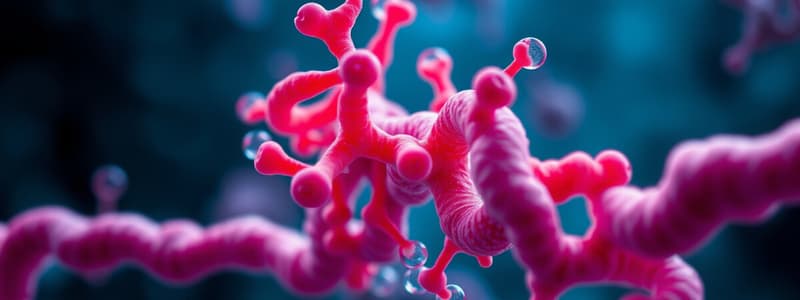Podcast
Questions and Answers
What happens to proteins that are broken down?
What happens to proteins that are broken down?
- They are stored for later use.
- They are converted into fats.
- They are completely eliminated from the body.
- Amino acids are recycled and used to build new proteins. (correct)
What is the goal of amino acid degradation?
What is the goal of amino acid degradation?
To produce molecules that can be oxidized for energy or converted to glucose.
Amino acids must be deaminated before they can be oxidized or converted.
Amino acids must be deaminated before they can be oxidized or converted.
True (A)
What is the key molecule in the degradation of amino acids?
What is the key molecule in the degradation of amino acids?
What occurs during transamination?
What occurs during transamination?
What is produced when the amine group of glutamic acid is removed?
What is produced when the amine group of glutamic acid is removed?
The reactions in the liver that produce urea involve the removal of an amine group from ____ acid.
The reactions in the liver that produce urea involve the removal of an amine group from ____ acid.
Where does protein synthesis occur?
Where does protein synthesis occur?
What controls the amount and type of protein synthesized?
What controls the amount and type of protein synthesized?
Flashcards
Fate of broken-down proteins?
Fate of broken-down proteins?
Amino acids are reused to build new proteins.
Amino acid degradation goal?
Amino acid degradation goal?
Make energy molecules or glucose.
Deamination before oxidation?
Deamination before oxidation?
Amino acids need to lose their amine group first.
Key molecule in amino acid breakdown?
Key molecule in amino acid breakdown?
Signup and view all the flashcards
Transamination: what happens?
Transamination: what happens?
Signup and view all the flashcards
Glutamic acid removal products?
Glutamic acid removal products?
Signup and view all the flashcards
Where does urea production occur?
Where does urea production occur?
Signup and view all the flashcards
Protein synthesis location?
Protein synthesis location?
Signup and view all the flashcards
What controls protein synthesis?
What controls protein synthesis?
Signup and view all the flashcards
Study Notes
Protein Breakdown and Use
- Proteins undergo degradation, resulting in amino acids that can be repurposed for new proteins or other nitrogen-containing compounds.
Amino Acid Degradation
- The primary aim is to create molecules for energy production in the citric acid cycle or to convert amino acids into glucose.
- Deamination is crucial: the amine group (NH2) must be removed for further processing.
- Following deamination, the resulting molecule is converted to pyruvic acid or intermediary keto acids within the citric acid cycle.
- Glutamic acid plays a significant role as a key molecule in this process.
Transamination Process
- Transamination involves transferring an amine group from one amino acid to a keto acid.
- This reaction creates glutamic acid from the modified keto acid.
Oxidative Deamination
- Occurs primarily in the liver, where the amine group of glutamic acid is released as ammonia (NH3).
- The process regenerates the corresponding keto acid.
- Ammonia combines with carbon dioxide (CO2) to form urea and water, facilitating nitrogen waste removal.
Keto Acid Modification
- Keto acids generated through transamination are further modified to create metabolites suitable for entry into the citric acid cycle.
Protein Synthesis
- Protein synthesis occurs on ribosomes, where enzymes facilitate the formation of peptide bonds to connect amino acids into polypeptide chains.
- Hormonal regulation directs the quantity and type of proteins produced during synthesis.
Studying That Suits You
Use AI to generate personalized quizzes and flashcards to suit your learning preferences.




